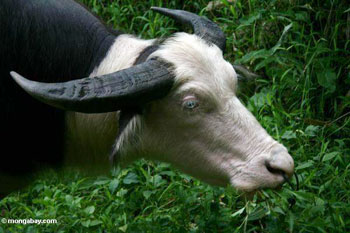Cattle produce more global warming gases than cars
Cattle produce more global warming gases than cars
mongabay.com
November 30, 2006
Livestock-rearing generates more greenhouse gases than transportation according to a new report from the United Nations (U.N.), which adds that improved production methods could go a long way towards cutting emissions of gases responsible for global warming.
“Livestock are one of the most significant contributors to today’s most serious environmental problems,” said Henning Steinfeld, a senior UN Food and Agriculture Organization (FAO) official and lead author of the report. “Urgent action is required to remedy the situation.”
The report, titled “Livestock’s Long Shadow—Environmental Issues and Options”, notes that cattle-rearing is also a major source of land and water degradation.
“The environmental costs per unit of livestock production must be cut by one half, just to avoid the level of damage worsening beyond its present level,” warns the report.
“Livestock’s Long Shadow” estimates that livestock sector accounts for 9 percent of carbon dioxide, 65 percent of nitrous oxide, and 37 percent of methane produced from human-related activities. Both methane (23 times) and nitrous oxide (296 times) are considerably more potent greenhouse gases than carbon dioxide. Livestock also generates 64 percent of human-related ammonia, which contributes to acid rain.

Human Threats to Rainforests—Cattle Pastures. The majority of the commercial destruction in the Amazon Basin from the 1960s to early 1990s was not due to logging or mining, but to cattle ranchers and land speculators who burned huge tracts of rainforest before planting the areas with African grasses for pasture. In Brazil, government figures attributed 38 percent of deforestation from 1966-1975 to large-scale cattle ranching. Cattle ranching has been even more widespread in parts of Central America, led by Costa Rica, which has one of the worst deforestation rates in Latin America. During the 1970s and early 1980s, stretches of rainforest were burned and converted into cattle pasture lands to meet American demand for beef. Reducing the impact of cattle ranching in the rainforest. Clearing for pastureland and land speculation purposes is a major cause of tropical forest loss, especially in Latin America. Cattle are an attractive investment for Amazonian farmers because they are a highly liquid capital asset with low marginal costs once forest has been cleared. Cattle are used to establish land claims on otherwise “unoccupied” rainforest land and can be used as a hedge against inflation. Brazil claims soy and beef not responsible for Amazon deforestation. Brazil rejected claims that soybean farms and cattle pasture were destroying the Amazon rainforest, according to a report from Reuters. At the opening of an organic food products fair in Sao Paulo, Agriculture Minister Luis Carlos Guedes Pinto said that only 0.27 percent of Brazil’s soybean crop is grown in the Amazon region, while less than 1.5 percent of Brazil’s beef for export comes from the rainforest. |
The report notes that the contribution of livestock to global warming will likely increase in coming years as global meat production is projected to more than double from 229 million ton from 1999/2001 levels to 465 million metric tons in 2050 and milk output is expect to jump from 580 to 1043 million metric tons. The report says that worldwide, the livestock sector is growing faster than any other agricultural sub-sector, providing livelihoods for about 1.3 billion people and contributing about 40 percent to global agricultural output. It adds that in poor countries, livestock are also a source of renewable energy and fertilizer.
The report estimates that livestock currently use 30 percent of the Earth’s land surface and that even more land is used to produce feed for livestock. It notes that forest clearing for livestock pasture is a “major driver of deforestation, especially in Latin America where, for example, some 70 per cent of former forests in the Amazon have been turned over to grazing.”
The report says that livestock cause other problems as well.
-
“At the same time herds cause wide-scale land degradation, with about 20 per cent of pastures considered degraded through overgrazing, compaction and erosion. This figure is even higher in the drylands where inappropriate policies and inadequate livestock management contribute to advancing desertification.
The livestock business is among the most damaging sectors to the earth’s increasingly scarce water resources, contributing among other things to water pollution from animal wastes, antibiotics and hormones, chemicals from tanneries, fertilizers and the pesticides used to spray feed crops.”
“Livestock’s Long Shadow” says that addressing livestock issues requires a multi-faceted approach including reformulating animal diets, introducing “soil conservation methods together with controlled livestock exclusion from sensitive areas; setting up biogas plant initiatives to recycle manure; improving efficiency of irrigation systems; and introducing full-cost pricing for water together with taxes to discourage large-scale livestock concentration close to cities.”
This article is based on a news release from the U.N.